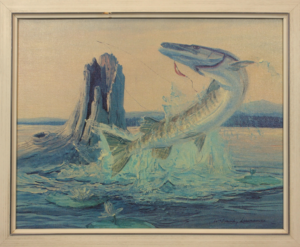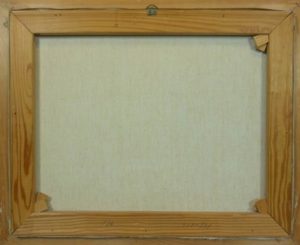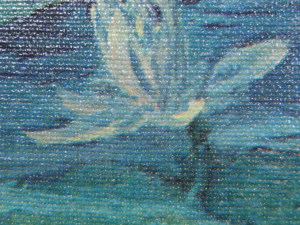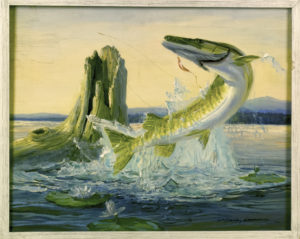Are you looking at a work of art, but can’t decide whether you’re looking at an original painting or a reproduction? Don’t panic. To bust the vast majority of repros all you need to do is look closely.
Ask yourself if there a reason the work looks suspicious? Maybe the colors look a little off, like an old Kodachrome slide or that faded poster that used to hang in your dorm room? Maybe the texture of the surface seems wrong; it looks like the paint is applied with heavy impasto (meaning thick, loose, brushstrokes) but the surface is flat as a pancake? Or the surface has texture but it seems pattern-like and doesn’t relate to the brushstrokes as defined by their colors? All of these observations should set off alarm bells.
Now look even more closely. If, like me, you’re over 40 you may need a magnifying glass or a loupe. Are you seeing actual brushstrokes or something different? Consider this work by William Goadby Lawrence, depicting a leaping Tiger Muskellunge (see figures 1 & 2). It looks promising, although the palette seems to be missing yellows tones, so the fish and the lily pads look blue. A quick look at the back confirms that it is executed on canvas rather than posterboard; a good sign but far from definitive.

Figure 1: Possibly William Goadby Lawrence (American, 1913-2002), Tiger Muskellunge, medium to be determined.

Figure 2: Reverse of object in figure 1.
One can print on cloth or even mount paper to canvas. But a closer look reveals two important factors (see figure 3). The “paint” isn’t applied in brushstrokes at all. It is made up of a dot matrix, like the pixels on your computer screen. Even Seurat and the Pointillist painters of the late 19th century didn’t paint with dots like this. Furthermore, while the texture of the underlying canvas is visible, there is no texture to correspond to the brushstrokes. This work is clearly a photo-offset reproduction. For comparison sake, take a look at the original painting (figure 4). Note the difference in both the color and texture.

Figure 3: Detail of object in figure 1, photo-offset printed on canvas.

Figure 4: William Goadby Lawrence (American, 1913-2002) Tiger Muskellunge, Sold for: $1,175
Thanks to new technologies there are other types of reproductions, such as giclées (basically high-quality inkjet prints), that are slightly harder for beginners to detect, but the same issues of texture and color apply. As you might expect, the value for reproductions, even by well-regarded artists, is often a small fraction of the value of original works. This is why it pays to have a practiced eye. Look closely utilizing the tips outlined in this post, and if you’re not certain, call us up at (508) 970-3206 to make an appointment, and we will be happy to take a look with you.

Thank you for the information in the article. It was very interesting.
An article on how reproductions are done in China would be helpful. They are often sold as “hand painted”, but I am not so sure. Is there some type of “camera obscura” device that they use to “paint”? The Chinese have been reproducing art for centuries, but I haven’t found any info on their current methods for reproducing paintings.
Any information would be appreciated.
This would be a broad topic, indeed! Some are prints, some are painted prints, and some are real paintings. Where identifying photo-reproductions is a finite topic that can be explained easily at an introductory level, your topic – though a terrific idea – would be tough to teach thoroughly without potentially leading a novice astray.
Having said this perhaps a “some issues to watch for” approach might work.
Thank you Robin.
Hi Robin, was wondering how often you sense is incorrect? that you in fact mis diagnosed a painting as fake when it was in fact real?